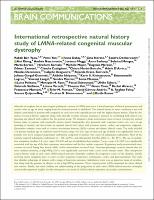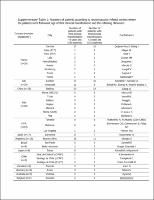| dc.contributor | Vall d'Hebron Barcelona Hospital Campus |
| dc.contributor.author | Yaou, Rabah Ben |
| dc.contributor.author | Yun, Pomi |
| dc.contributor.author | Dabaj, Ivana |
| dc.contributor.author | Norato, Gina |
| dc.contributor.author | Donkervoort, Sandra |
| dc.contributor.author | Xiong, Hui |
| dc.contributor.author | Gómez Andrés, David |
| dc.date.accessioned | 2022-02-24T16:06:49Z |
| dc.date.available | 2022-02-24T16:06:49Z |
| dc.date.issued | 2021-11 |
| dc.identifier.citation | Ben Yaou R, Yun P, Dabaj I, Norato G, Donkervoort S, Xiong H, et al. International retrospective natural history study of LMNA-related congenital muscular dystrophy. Brain Commun. 2021 Jul;3(3):fcab075. |
| dc.identifier.issn | 2632-1297 |
| dc.identifier.uri | https://hdl.handle.net/11351/7075 |
| dc.description | Laminopaties; Distròfia muscular; Múscul estriat |
| dc.description.sponsorship | This work was supported by the AFM-Telethon, the Institut National de la Santé et de la Recherche Médicale (INSERM) and Sorbonne Université (R.B.Y., G.B.), intramural funds of the National Institute of Neurological Disorders and Stroke, National Institutes of Health (C.G.B.), Cure-CMD (A.R., G.B., R.B.Y.), The Andres Marcio Fondation (G.B., R.B.Y). and the Cedars-Sinai Diana and Steve Marienhoff Fashion Industries Guild Endowed Fellowship in Pediatric Neuromuscular and the Fashion Industries Guild Endowed Fellowship for the Undiagnosed Diseases Program (T.M.P). |
| dc.language.iso | eng |
| dc.publisher | Oxford University Press |
| dc.relation.ispartofseries | Brain Communications;3(3) |
| dc.rights | Attribution 4.0 International |
| dc.rights.uri | http://creativecommons.org/licenses/by/4.0/ |
| dc.source | Scientia |
| dc.subject | Distròfia muscular - Fisiologia patològica |
| dc.subject | Distròfia muscular - Aspectes genètics |
| dc.subject.mesh | Muscular Dystrophies |
| dc.subject.mesh | /pathology |
| dc.subject.mesh | Lamin Type A |
| dc.subject.mesh | /genetics |
| dc.title | International retrospective natural history study of LMNA-related congenital muscular dystrophy |
| dc.type | info:eu-repo/semantics/article |
| dc.identifier.doi | 10.1093/braincomms/fcab075 |
| dc.subject.decs | distrofias musculares |
| dc.subject.decs | /patología |
| dc.subject.decs | lamina de tipo A |
| dc.subject.decs | /genética |
| dc.relation.publishversion | https://doi.org/10.1093/braincomms/fcab075 |
| dc.type.version | info:eu-repo/semantics/publishedVersion |
| dc.audience | Professionals |
| dc.contributor.organismes | Institut Català de la Salut |
| dc.contributor.authoraffiliation | [Ben Yaou R] Sorbonne Université, Inserm, Institut de Myologie, Centre de Recherche en Myologie, F-75013 Paris, France. APHP-Sorbonne Université, Neuromuscular Disorders Reference Center of Nord-Est-Île de France, FILNEMUS, ERN-Euro-NMD, Service de Neuromyologie, Institute de Myologie, G.H. Pitié-Salpêtrière Paris F-75013, France. [Yun P, Norato G, Donkervoort S] Neuromuscular and Neurogenetic Disorders of Childhood Section, National Institute of Neurological Disorders and Stroke, National Institutes of Health, Bethesda, MD, USA. [Dabaj I] APHP-Université Paris-Saclay, Neuromuscular Disorders Reference Center of Nord-Est-Île de France, FILNEMUS, ERN-Euro-NMD, Pediatric Neurology and ICU Department, DMU Santé Enfant Adolescent (SEA), Raymond Poincaré University Hospital, Garches France. INSERM U 1245, ED497, School of Medicine, Rouen University, Rouen, France. [Xiong H] INSERM U 1245, ED497, School of Medicine, Rouen University, Rouen, France. [Gómez-Andrés D] Servei de Neurologia Pediàtrica (ERN-RND - EURO-NMD), Vall d'Hebron Hospital Universitari, Barcelona, Spain. Vall d'Hebron Institut de Recerca (VHIR), Barcelona, Spain |
| dc.identifier.pmid | 34240052 |
| dc.identifier.wos | 000674976500008 |
| dc.rights.accessrights | info:eu-repo/semantics/openAccess |


